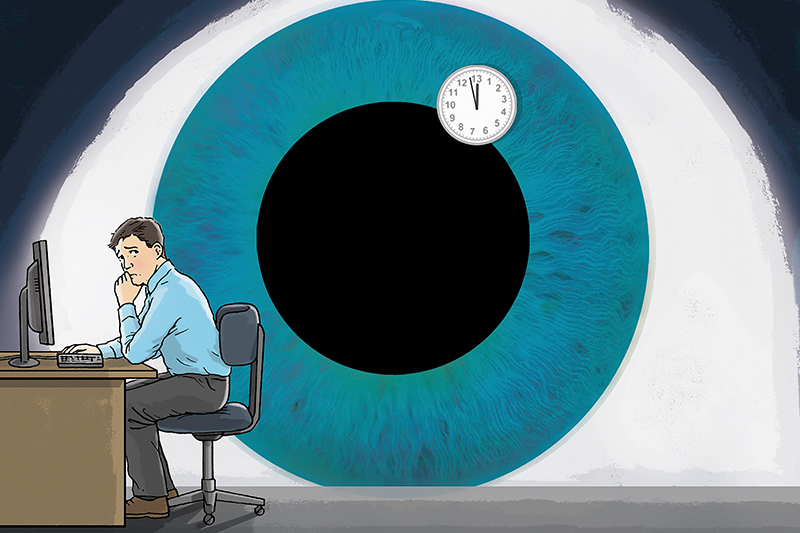Talent Development Leader
Measure Versus Monitor Productivity
The use of employee-monitoring software has increased due to employers’ uncertainty about workers’ at-home productivity.
Mon Mar 13 2023

Global demand for employee-monitoring software was 57 percent higher in 2022 than it was in 2019. That’s according to research from Top10VPN, an internet security and digital rights firm.
“Fearful that remote work would lead to a drop in productivity, employers have turned to remote monitoring software to ensure their staff work effectively from home,” Top10VPN notes.
That sentiment is backed by research from Microsoft, which found that 85 percent of leaders say that the shift to hybrid work has made it challenging to feel confident that employees are being productive. Microsoft’s 2022 Work Trend Index Pulse surveyed some 20,000 people across 11 countries and analyzed trillions of Microsoft 365 productivity signals, along with LinkedIn labor trends and Glint People Science findings.
Microsoft CEO Satya Nadella has termed the concept “productivity paranoia” on the part of employers, whereby managers fear that lost productivity is the inevitable result of a remote workforce—regardless of the number of hours employees worked, the number of meetings they attended, or the increase of other activity metrics. And Microsoft’s data reveals there is a stark disconnect between how leaders and remote workers view their productivity. While 87 percent of employees believe they are productive at work, only 12 percent of managers say they have full confidence that their team is productive.
What Big Brother is watching
While not all monitoring software products offer the same functionality, and some are considerably more invasive than others, there are typical features that employers seek, such as keystroke logging, screen monitoring, internet monitoring and filtering, webcam surveillance, audio recording, email monitoring, mobile device access, user interaction alerts, and time tracking.
Top10VPN’s analysis found that keystroke logging was available in 81 percent of monitoring applications. That is a potentially intrusive feature that enables employers to view their employees’ every click, touch of the keyboard, and conversation. Six in 10 applications offer ways to monitor instant messaging, enabling managers to access and review their direct reports’ private messages on popular social media chat platforms.
In addition, two-thirds of monitoring applications include a feature that sends user action alerts to employees’ managers. According to Top10VPN, a user action alert notifies employers when a behavior they have predefined as “undesirable” is taking place. For example, some applications enable companies to set up behavioral alerts that identify when a worker may be trying to access an “unproductive” website, copy sensitive files, or even simply sit idle for a set amount of time.
That begs the question: Do monitoring tools boost or diminish employees’ productivity? What’s more, what other issues start to surface because of their use, such as privacy, equity, and other ethics-related concerns?
Find a reasonable balance
Some pre-pandemic research suggests that when companies use such surveillance tools inconsistently or in an overly rigid manner, monitoring every move of their staff, they signal distrust. Microsoft notes that “as some organizations use technology to track activity rather than impact, employees lack context on how and why they’re being tracked, which can undermine trust and lead to ‘productivity theater.’”
Trust is often cited as a lynchpin of employee engagement, and Gallup research has long tied engagement to important organizational outcomes, including worker productivity. According to Gallup’s State of the Global Workplace: 2022 Report, employee engagement has slumped to a seven-year low, with only 32 percent of employees engaged and 17 percent actively disengaged at work. More importantly, workers who are not engaged or who are actively disengaged cost the world $7.8 trillion in lost productivity in 2021.
Rather than monitor knowledge workers’ “busyness” to ensure their productivity, WorkHuman advises employers to measure performance. For example, in a blog post, the human capital management software provider writes that the first step toward measuring productivity is for leaders to set up a standard output such as isolating and detailing individual tasks so employees understand what is expected of them.
Next, organizations must also identify uncontrollable factors that can affect employees’ capability to achieve goals. For instance, a standard of 50 calls per day for reps working in a customer service center may not be an attainable goal for some individuals due to the number of minutes difficult customers take per call. As a result, the company will need to adjust their standards.
Quality over quantity
With remote work set to continue in some form for the foreseeable future, invasive employee-monitoring software solutions are likely here to stay. According to futurist and author Bernard Marr in a Forbes article, “Businesses are likely to continue to invest in technology designed to track and monitor their activity in 2023. Organizations that get it right will be those that ensure it is implemented in a fair way, with a focus on assessing quality of employee output rather than quantity of input.”
The talent development function is uniquely positioned to work with leaders and teams to pinpoint and contextualize the factors that affect employee productivity, output, and overall performance. TD leaders can work with other managers throughout the business on how they can effectively and ethically track employee performance and help their teams stay on track and meet goals.
Read more from Talent Development Leader.
You've Reached ATD Member-only Content
Become an ATD member to continue
Already a member?Sign In
